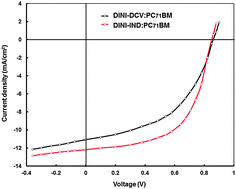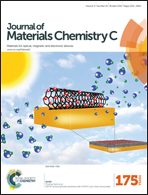Solution processed bulk heterojunction solar cells based on A–D–A small molecules with a dihydroindoloindole (DINI) central donor and different acceptor end groups†
Abstract
Four acceptor–donor–acceptor (A–D–A) small molecules with dihydroindoloindole (DINI) as the central donor unit and different acceptor end groups such as dicyanovinylene (DCV), indenedione (IND), cyanoacrylate (CA) and rhodanine (Rho) linked through bithiophene as the π-linker, DINI-DCV, DINI-IND, DINI-CA and DINI-Rho, were designed and synthesized for the application as donor materials along with PC71BM as an acceptor for solution processed organic bulk heterojunction solar cells. The effect of acceptor end groups on the photovoltaic performance was investigated. The organic solar cells (OSCs) based on as cast DINI-IND showed the highest power conversion efficiency of 3.04%, as cast DINI-CA showed the lowest PCE of 1.63% and the other two exhibit a PCE in between them. These results showed that acceptor end groups affect the overall performance of the cells. The PCE of OSCs has been further improved up to 7.04% and 6.16% employing two-step annealing (TSA) treated DIN-IND : PC71BM (1 : 2) and DIN-CN : PC71BM (1 : 2), respectively. The enhancement in the PCE of OSCs with TSA treated active layers is attributed to the better nanophase morphology, the increase in the crystalline nature and light harvesting efficiency and more balanced charge transport and charge collection probability.


 Please wait while we load your content...
Please wait while we load your content...